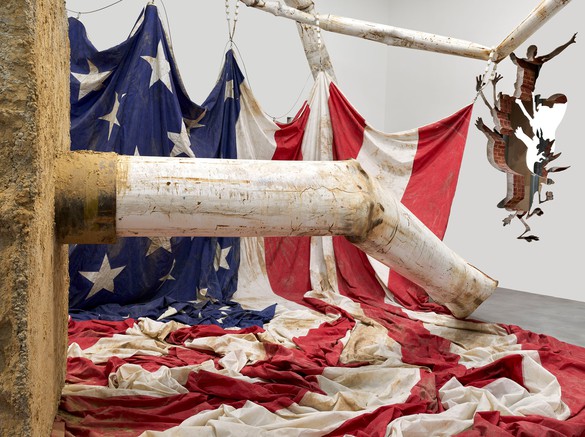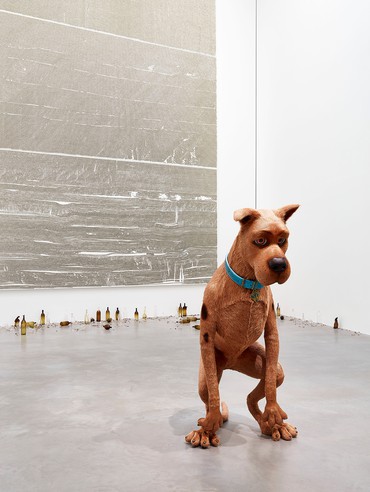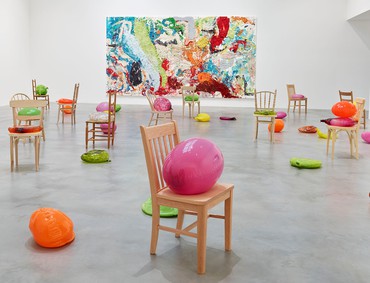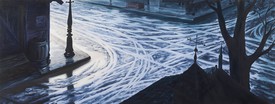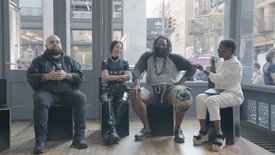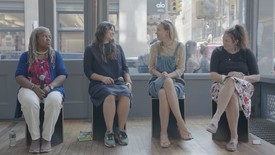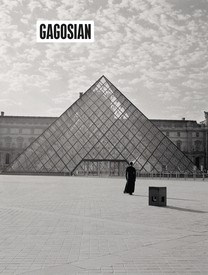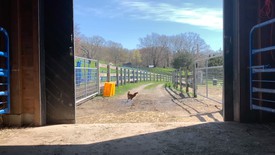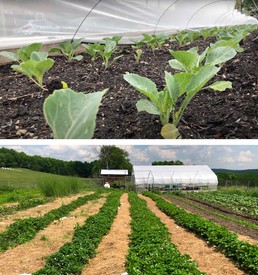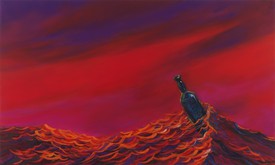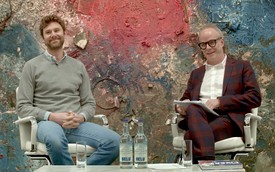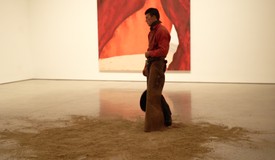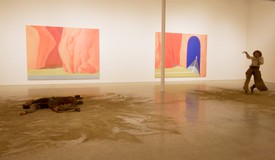Ali SubotnickLet’s talk about the Newport Street Gallery show. You mentioned that it’s sort of centered around self-portraiture, so how does the giant flagpole fit into that narrative?
Dan ColenWell, the flagpole [The Big Kahuna (2010–17)] is a readymade that I’ve intervened with, not only physically, but there’s a narrative around it as well. I conceived of it right after rehab so it’s a self-portrait of me at the time, but now it’s almost like a new artwork because the context is so different.
ASAnd what the flag means today has changed so much. But is it about patriotism or America?
DCIt’s an American flag, and I am an American. In its defeated form it is a self-portrait, this battered thing recovering from multiple traumas. Was I beating up something that I believed in or separating myself from it? It symbolized that inner turmoil. Like the flag, I was battered, but hopeful. For me, that flag represented faith in my works and in myself: self-confidence and self-love. But doubt is just as big a part of the creative process as confidence and faith are. The flag is really about that tension.
ASSo, do you see that as the centerpiece of the show?
DC: The flag is the first thing you’re confronted with in a way. But, as far as a survey goes, this show is pretty site specific. I’ve always struggled with whether my audience connects to the through-line in my work, but it’s all one thing to me. This show allows that experience to be communicated to my audience.
ASWas Scooby Doo a significant character for you growing up?
I wanted to explore that process of transforming something, but keeping the content the same, just changing the form or context. I am interested in that place to put your dreams or desires and as a kid [the cartoon] is the first place it happens.
Dan Colen
DCNo. Neither Disney nor Scooby are reflections on my childhood. The Scooby Doo (2002) movie came out right after 9/11 and I thought it was ridiculous to take that simple, flat, two-dimensional thing, and transform it into a three-dimensional object. Are the Hells Angels’ bikes the Hells Angels’ bikes if I’ve remade them? It’s obvious it’s Scooby, but now he has a form and he is interacting with live people. I wanted to explore that process of transforming something, but keeping the content the same, just changing the form or context. I am interested in that place to put your dreams or desires and as a kid [the cartoon] is the first place it happens. But Scooby [Haiku (2015–17)] is very formal for me. Taking something that began flat and was instilled with the illusion of life through CGI special effects—I felt the need to fully realize the character. To describe his form, his surface, his texture, his structure, the way he moved. The piece really becomes about the relationship between Scooby and the mechanism. They’re formal relationships. Both [objects] took the same series of considerations to make. They contrast with one another in so many ways—shape, material, narrative, movement—but they are clearly and literally connected by a single thread.
ASBut there must have been something about the character that you identified with.
DCWell, like the flag, it’s flawed with potential, and that’s what Scooby is. Scooby is always failing but he’s also succeeding. He trips into the solution. Or that idea of high and low, you know, taking the gum on the sidewalk and putting it on a canvas. Wile E. Coyote has always been a character that I tuned into. I love that he begins where he ended. His new idea comes out of the failure of his old idea, but they’re all the same thing and it keeps going. There’s no separation between the answer and the question or the problem and the solution and the end and the beginning.
ASAnd visitors will confront Scooby on a visceral, corporeal level, even more deeply than in the movie.
DCYeah and this is a big thing in the show. You walk into a room and the flag seems like the content, but in fact a 70,000-pound piece of concrete sits on the flag, ripped out of the earth, positioned like an art object. The flag is basically being shat out of it. So, searching for the content of the piece happens with this thing that was buried in the earth that's pure material, pure form.
ASYou’re really making it out of concrete?
DCYeah. I always wanted this to be a readymade. It’s 13 × 8 × 5 feet, so you’re confronted with that but you’re constantly overwhelmed by this giant American flag. Then in another room you see Scooby Doo, this highly fabricated construction and you think you understand the material and how it works, that’s what it’s about, but halfway through the show, you’re confronted by the thing controlling it—a metal cylinder that’s all mechanics. They’re choreographed in opposing ways, but a string binds their movements. The content seems to be in Scooby, kind of like the flag, but in fact, the cylinder controls Scooby. When you’re in front of it you have to deal with it as an aesthetic object.
ASDoes it make sound?
DCScooby is silent, but the cylinder will make a little bit of sound. But you’ll hear the shoes tap dancing on the ceiling [Shoes (2013–17)] the whole time. They’re kind of calling you, almost like a figment of the imagination.
ASAnd then Livin and Dyin (2012–13), the lifelike sculptures of the cartoon characters, Roger Rabbit, Wile E. Coyote, and the Kool-Aid Man, with your naked body double, all crash through the wall. . .
DCThat piece is like a self-portrait, they’re like. . .
ASDifferent sides of you?
DCYeah, or my friends, lovers, but it’s kind of me still.
ASMaybe I’m reading this too literally, but initially I was thinking of that piece as a representation of a breakthrough, but also failure. They make it through the wall, but they all collapse in the end.
DCWell, Livin and Dyin explores time because the sculpture starts in a different place and the narrative is implied. Creation through destruction is a big part of Livin and Dyin. It’s a very simple, old dichotomy that artists have used for a long time. The Western Wall is this holy object that came from the destruction of the temple. I’ve always imagined [Livin and Dyin] as an orgy where you don’t know if it’s after or before climax, it’s about that edge—where does it begin, where does it end? This show is about those dichotomies—form and content, material and narrative—opposing or not necessarily related things that are both pivotal parts of one’s experience of the show. The scale and arrangement force the viewer to confront the object, material and narratives. I think of myself as a painter still, even though I'm making things that are far beyond that. I want my audience to have the full experience that I’m cultivating in the studio, and the objects symbolize the experience in a way.
ASI always wonder what drives a painter to make objects. You know the saying, “Sculpture is what you back into when you're looking at a painting?” [laughs]
DCYeah, painting was almost a default for me, but like I mentioned, I don’t think of myself as a virtuoso. I find it very painful to make paintings. I use painting to connect to all of painting’s history, and mark making, technique and touch. You know, my decisions are important, but there is something bigger than that happening. So, whether it’s his fur or the sheen of the finish or the movement, it’s the equivalent of a layer of paint. Paintings all have these things but they’re muted, and with different mediums and technologies you can explore the nuances in painting and explode them. A mark is just a decision, a touch that can go in so many different directions. It can be transparent, opaque, blue or green, and there’s so much that you're not seeing, so many decisions. That’s where the art happens. I think understanding that experience of making is so important for the viewer. The viewer doesn’t ever get to witness it, but they have to know that it was there and there has to be a space for the imagination.
ASIt goes back to when you were teaching yourself how to paint and breaking down every little step and not thinking so much about what you’re painting, but how.
DCIt’s always been an education for me. I’ve always wanted to share failures and my thought process and moments of my studio, and it’s made it confusing I think. I hope as I wrap circles around it in the next few decades, I’ll end up being able to share even more. I’m still searching and trying to figure things out in the moment. I’m not an academic. It’s intuitive and exploratory; I’m just following, sniffing things out and trusting that I’m in the right place.
Artwork © Dan Colen. Photos by Prudence Cumings Associates © Victor Mara Ltd. This exchange is an excerpt from an interview that appears in Dan Colen–Sweet Liberty, published by Other Criteria Books in association with Newport Street Gallery, London, on the occasion of the exhibition Dan Colen: Sweet Liberty. Publication available here.
